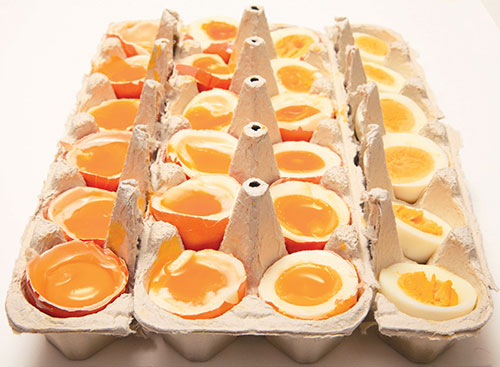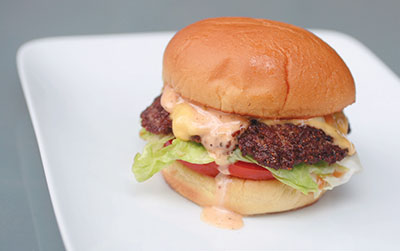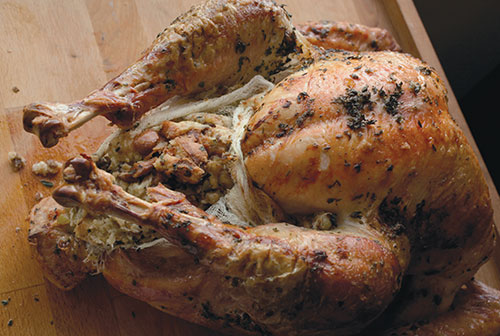Parsley, Sage, Thermocouple, and Thyme
By Eric Schulze
A brief review of The Food Lab: Better Home Cooking Through Science, by J. Kenji López-Alt
A brief review of The Food Lab: Better Home Cooking Through Science, by J. Kenji López-Alt

DOI: 10.1511/2015.117.424
THE FOOD LAB: Better Home Cooking Through Science. J. Kenji López-Alt. 958 pp. W. W. Norton, 2015. $49.95.
Some anthropologists have argued that the discovery of cooking was the greatest human evolutionary adaptation to take place in the period, loosely speaking, after bipedal grassland hunting and before adult lactose tolerance. The development occurred thanks in large part to the Maillard reaction: the response of proteins to sugars under high heat, which releases myriad new flavor compounds, an effect first reported in 1913 and essentially understood by 1953. Not only did humans’ discovery of cooking enable them to adopt an omnivorous diet, but exposing food to heat also unlocked novel nutrients, flavors, and aromas, enhancing the relatively limited diet humans had previously relied on. The ability to cook encouraged both the discovery of new food sources and the development of agriculture, which contributed to humanity’s rapid evolutionary development.
In his book The Food Lab, J. Kenji López-Alt captures what it must have felt like to be one of those first geeky humans who roasted a beast, tasted it, and mused, “Let me repeat this a few more times to see if I’m right.”

Image copyright © 2015 by Kenji López-Alt. With permission of the publisher W. W. Norton & Company, Inc. All rights reserved.
Although this is López-Alt’s first book, the MIT-educated chef and food columnist has been writing about the science of cooking for years, gaining a large and enthusiastic following. Unlike most cookbook authors, he does not care whether you learn, or even try, any of the recipes he presents. More than a cookbook, The Food Lab is the culmination of years of blogging and a lifetime of eating, portioned into empirical realms, such as how to cook protein, the science of emulsions, the science of eggs (if any topic deserves its own chapter, it’s this), and the right tools for each experiment. Like any good story, it’s the journey, not necessarily the destination, that interests López-Alt. In The Food Lab , he believes that you too might enjoy the journey.
With honesty and informality, López-Alt communicates simple scientific approaches to improving or modifying the common foods he—and many of his readers—grew up eating. He notes that “in many ways, the blog format is ideal for the type of work I do,” explaining that The Food Lab grew naturally from this online work. It serves as a sort of open lab notebook meant for public consumption and benefit. Who wouldn’t want to taste-test 10,000 chocolate chip cookie variations in the pursuit of an ideal childhood memory (for science, naturally)?
Using science to demystify what actually happens when food is cooked, The Food Lab then builds on this information to demonstrate the best methods for cooking classic dishes, which may not be what you expect. As the author observes, “In many (most?) cases, the most traditional methods of cooking are in fact not the ideal way to reach the end results.” By questioning cuisine entirely, he Cartesianed himself into a contented philosophical corner that might approximate “I cook, therefore I love.” From here, he starts.
As a student of science, López-Alt presumes he knows nothing for sure until the delicious evidence is in. Ever ready to pay homage to two great loves—bacon and (Roger) Bacon—he subjects even the humblest foods and the most basic procedures to rigorous experimentation. In that chapter on eggs, for example, a detailed section explores an array of factors involved in boiling them: cooking time, cooking temperature (full boil versus simmer, subsimmer, or quiver), altitude, the proportion of water to eggs in the pan, and the point at which the eggs are introduced into the water.

Image copyright © 2015 by Kenji López-Alt. With permission of the publisher W. W. Norton & Company, Inc. All rights reserved.
To develop recommendations for making cheeseburgers, he uses his knowledge of chemistry as a starting point and then forges ahead with tests to determine which seasoning process yields the best result. It turns out that salting solely the exterior of ground beef patties just before cooking ensures not only proper flavor but also proper burger structure. (Why? Because muscle proteins are first partially dissolved by the salt, then relinked in a molecular mesh that encases the unsalted ground meat—rendering the effects of the Maillard reaction produced by high heat all the more delicious. If you salt the patty meat throughout, the burger’s cooked texture becomes firmer, more rubbery. But congratulations: You just made sausage!)
The experiments in The Food Lab might not make it past the scrutiny of academic peer review, but the scientific method is proudly on display, flaunting its ability to tease out the weft within the tapestry of cuisine. What’s more, López-Alt offers up his work for review in a way that many professional scientists could only dream of (or hightail away from, depending on the scientist’s caliber and inclination). He was one of the first and best chefs to wield the social Web to his advantage. A frequent diver into comments sections, he regularly tweets to fans, subjecting himself to copious empirical scrutiny by devotees. This practice pays off in his book, where López-Alt anticipates the questions you might rightfully ask, and in his strongest writing in The Food Lab, answers them plainly, directly, and with a passion that indicates a desire to see the world eat with more nerdery.

Image copyright © 2015 by Kenji López-Alt. With permission of the publisher W. W. Norton & Company, Inc. All rights reserved.
Besides applying evidence to cooking, López-Alt is at his best when The Food Lab resembles its eponymous column on the food blog Serious Eats by giving ample space to frequently asked questions, or FAQs. In his column, López-Alt often uses FAQ segments to address long-held misconceptions about cuisine and cooking. They play a similar role in the book, appearing under headings such as “All about Oil” and “All about Asparagus.” The answers are instructive and often surprising: No, searing meat does not “lock in” juices—in fact, it does the exact opposite, with the heat of cooking wringing out all that precious moisture in the muscle fibers, like squeezing a wet sponge. Yes, brining does make your Thanksgiving turkey juicier, although the notion of juiciness itself is a myth. As López-Alt notes, a “juicy” bird is actually one with a higher concentration of gelatinized collagen tricking our tongues into thinking we taste a lot more moisture than we actually do. No, you cannot “brine in flavors.” Osmosis and diffusion in living tissues don’t generally work that way. (Tip: Brine your turkey “dry” by simply salting the meat a la the López-Alt hamburger, and always rest meat after cooking.)
Nathan Myhrvold’s recent Modernist Cuisine similarly approached food with empirical rigor, but Myhrvold’s work, as beautifully artistic as it is, analyzed food in terms of algorithms and chemical formulas. López-Alt’s writing is more of a familial and anthropological love song, melodically scientific and personal.
Eric Schulze, PhD, is a molecular biologist, creative communities–builder, freelance writer, and television presenter focusing on the science of food, creativity, and public communication. Watch him on Smithsonian.com or follow him on Twitter and Instagram: @SciencEric.
Click "American Scientist" to access home page
American Scientist Comments and Discussion
To discuss our articles or comment on them, please share them and tag American Scientist on social media platforms. Here are links to our profiles on Twitter, Facebook, and LinkedIn.
If we re-share your post, we will moderate comments/discussion following our comments policy.